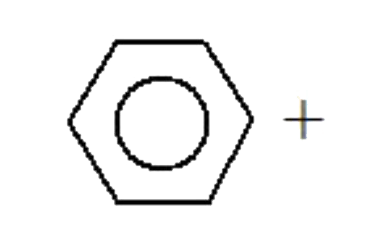Ph−CH=CH2ICl−−→P, Identify major product 'P' is :
Ph−C∣IH−CH2−Cl
Ph−C∣ClH−CH2−I
Ph−C∣ClH−CH2−Cl
Ph−C∣IH−CH2−I
The correct Answer is:B
To solve the problem, we need to identify the major product 'P' formed when phenylpropene (Ph-CH=CH2) reacts with iodine monochloride (ICL). Let's break down the reaction step by step.
Step 1: Identify the Reactants
The reactant is phenylpropene, which can be represented as Ph-CH=CH2. The other reactant is iodine monochloride (ICL).
Step 2: Mechanism of Reaction
1. Electrophilic Attack: The double bond in phenylpropene acts as a nucleophile and attacks the iodine in ICL. This results in the formation of a carbocation intermediate. The iodine atom becomes negatively charged (I-) and the chlorine atom leaves as a chloride ion (Cl-).
Intermediate: Ph-CH^+ -CH2-I
2. Formation of a Three-Membered Ring: The iodine ion (I-) has lone pairs and can stabilize the carbocation by forming a three-membered ring with the carbocation. This results in a cyclic intermediate where iodine is bonded to the carbocation carbon.
Intermediate: A three-membered ring with Iodine.
Step 3: Nucleophilic Attack
1. Nucleophilic Attack by Cl-: The chloride ion (Cl-) can attack one of the carbons in the three-membered ring. Since the carbocation is more stable at the carbon adjacent to the phenyl group (due to resonance), the Cl- will preferentially attack this carbon.
2. Formation of Products:
- Major Product: When Cl- attacks the carbon adjacent to the phenyl group, we get the major product:
- Ph-CH(Cl)-CH2-I
- Minor Product: If Cl- were to attack the other carbon (the one bonded to iodine), we would get a minor product:
- Ph-CH-I-CH2Cl
Step 4: Identify the Major Product
From the above analysis, the major product 'P' formed from the reaction of phenylpropene with ICL is:
- Major Product: Ph-CH(Cl)-CH2-I
Conclusion
The major product 'P' is Ph-CH(Cl)-CH2-I.
---
The reactant is phenylpropene, which can be represented as Ph-CH=CH2. The other reactant is iodine monochloride (ICL).
1. Electrophilic Attack: The double bond in phenylpropene acts as a nucleophile and attacks the iodine in ICL. This results in the formation of a carbocation intermediate. The iodine atom becomes negatively charged (I-) and the chlorine atom leaves as a chloride ion (Cl-).
Intermediate: Ph-CH^+ -CH2-I
1. Nucleophilic Attack by Cl-: The chloride ion (Cl-) can attack one of the carbons in the three-membered ring. Since the carbocation is more stable at the carbon adjacent to the phenyl group (due to resonance), the Cl- will preferentially attack this carbon.
- Major Product: When Cl- attacks the carbon adjacent to the phenyl group, we get the major product:
- Ph-CH(Cl)-CH2-I
- Minor Product: If Cl- were to attack the other carbon (the one bonded to iodine), we would get a minor product:
- Ph-CH-I-CH2Cl
From the above analysis, the major product 'P' formed from the reaction of phenylpropene with ICL is:
- Major Product: Ph-CH(Cl)-CH2-I
The major product 'P' is Ph-CH(Cl)-CH2-I.
Topper's Solved these Questions
- ORGANIC REACTION MECHANISMS - IIBOOK - RESONANCE ENGLISHCHAPTER - ORGANIC REACTION MECHANISMS - IIEXERCISE - APSP Part - 2
42 Videos
- ORGANIC REACTION MECHANISMS - IIBOOK - RESONANCE ENGLISHCHAPTER - ORGANIC REACTION MECHANISMS - IIEXERCISE - APSP Part - 3
22 Videos
- ORGANIC REACTION MECHANISMS - IIBOOK - RESONANCE ENGLISHCHAPTER - ORGANIC REACTION MECHANISMS - IIEXERCISE - Exercise-3 Part-2
34 Videos
- MOLE CONCEPTBOOK - RESONANCE ENGLISHCHAPTER - MOLE CONCEPTEXERCISE - ORGANIC CHEMISTRY(BASIC CONCEPTS)
27 Videos
- ORGANIC REACTION MECHANISMS-IVBOOK - RESONANCE ENGLISHCHAPTER - ORGANIC REACTION MECHANISMS-IVEXERCISE - APSP PART-3
22 Videos
Similar Questions
Knowledge Check
CH2=CH−CH=CH2CCl3Br−−−−→product. The major product is :
ABr−CH2−CH=CH−CH2−CCl3BCH2=CH−CH∣Br−CH2−CCl3CCH2=CH−CH∣CCl3−CH2−BrDnone is correct
CH2=CH−NO2+HBr→P, The major product P is
View SolutionCH3CH=CH2H/H2O−−−−→ major product is
View SolutionCH3−CH=CH2+HOBr→P, The major product P is
View Solution
 + CH3−CH2−CH2−CH2−ClAlCl3−−→ Hydrocarbon (X) major product X is
+ CH3−CH2−CH2−CH2−ClAlCl3−−→ Hydrocarbon (X) major product X is
View SolutionCH3−CH=CH2CI−I−−−→P,Pis
View SolutionCH3−CH2−CH2−CH3+Cl2hv−−→ Major product :
View SolutionCH3−CH=CH2NOCl−−−→ Product, product is :
View Solution
